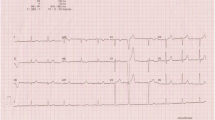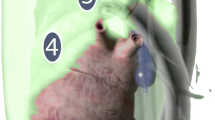Abstract
Background:
Type A aortic dissection is a rare, but life-threatening disease. The prognosis is determined by an accurate and immediate diagnosis.
Case Study:
A patient with suspected type A dissection based on outward transesophageal echocardiography (TEE) findings is reported. Renewed TEE showed dilation of the ascending aorta with pronounced wall thickness. A membrane-like structure was found in the ascending aorta. M-mode technique revealed movement of the suspected membrane that was partially in parallel to the aortic wall. Thus, there were severe doubts on the presence of type A dissection. By contrast, typical intimal rupture was found in the descending aorta. Computed tomography (CT) and angiography showed aortic dilation and an extended wall hematoma deriving from the entry at the descending part. There was no evidence of type A dissection.
Conclusion:
TEE is a noninvasive diagnostic tool to assess aortic dissection of type A with a sensitivity of 90–98% that is equal to CT or magnetic resonance imaging (MRI) solely. Complementary use of CT or MRI could improve the diagnostic accuracy. False-positive findings could result from echocardiographic artifacts concealing an intimal flap in the ascending aorta. Echo reverberations in dilated or calcified aortas had been judged to account for this phenomenon. In the present case, it could be assumed that the extended wall hematoma in accordance with vessel dilation mimicked the membrane-like structure. Oscillation or flutter of the suspicious intimal flap independently of aortal wall movement seem to be mandatory to avoid false-positive diagnoses. Ancillary findings such as flow signals, intimal fenestration or thrombosis are helpful to enhance the diagnostic specificity of TEE.
Zusammenfassung
Hintergrund:
Die Aortendissektion Typ A ist eine seltene, aber lebensbedrohliche vaskuläre Erkrankung. Die Prognose hängt wesentlich von einer raschen und sicheren Diagnosestellung ab.
Kasuistik:
Berichtet wird über eine Patientin, die aufgrund einer mutmaßlichen Typ-A-Dissektion notfallmäßig zugewiesen wurde, nachdem zur Vordiagnostik eine transösophageale Echokardiographie (TEE) in der zuweisenden Klinik durchgeführt worden war. Eine erneute TEE-Untersuchung zeigte eine Dilatation der Aorta ascendens mit deutlicher Wandverdickung. Darüber hinaus kam eine membranartige Struktur in der aszendierenden Aorta zur Darstellung. Wie die echokardiographische M-Mode-Darstellung zeigte, war das Bewegungsmuster dieser Struktur zumindest teilweise parallel zur Aortenwand, was erhebliche Zweifel am Vorhandensein einer Dissektion aufkommen ließ. Eine typische Intimaruptur fand sich dagegen in der Aorta descendens. Mittels Computertomographie (CT) und Angiographie zeigte sich eine deutliche Dilatation der Aorta ascendens mit ausgedehntem Wandhämatom als Resultat einer Eintrittspforte im Bereich der Aorta descendens, wohingegen keine Typ-A-Dissektion vorhanden war.
Schlussfolgerung:
Die TEE als nichtinvasives Verfahren zur Erfassung von Typ-A-Dissektionen hat ähnlich der CT oder Magnetresonanztomographie (MRT) eine Sensitivität von 90–98%. Die Kombination dieser Methoden erhöht die diagnostische Genauigkeit. Schallartefakte können eine Dissektionsmembran vortäuschen und somit zu falsch positiven Diagnosen führen. Eine Reflexion des Echosignals (Reverberation) dürfte bei einer Dilatation und starken Kalzifikation der Aorta hierfür verantwortlich sein. Es ist anzunehmen, dass im vorliegenden Fall das ausgedehnte Wandhämatom und die Gefäßdilatation zur fälschlichen Darstellung der membranartigen Struktur geführt haben. Ein Oszillieren oder Flattern einer mutmaßlichen Membran unabhängig von der aortalen Wandbewegung scheint zur sicheren Diagnosestellung ein notwendiges Kriterium, um falsch positive Resultate zu vermeiden. Zur Verbesserung der Spezifität der TEE-Untersuchung sind zusätzliche Anhaltspunkte wie z. B. die Darstellung der Eintrittspforte in ein zweites Lumen oder die dopplersonographische Visualisierung atypischer Flussphänomene hilfreich.
Similar content being viewed by others
Author information
Authors and Affiliations
Corresponding author
Rights and permissions
About this article
Cite this article
Alter, P., Herzum, M. & Maisch, B. Echocardiographic Findings Mimicking Type A Aortic Dissection. Herz 31, 153–155 (2006). https://doi.org/10.1007/s00059-006-2791-0
Received:
Accepted:
Published:
Issue Date:
DOI: https://doi.org/10.1007/s00059-006-2791-0




